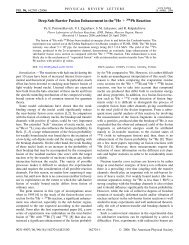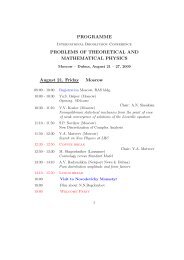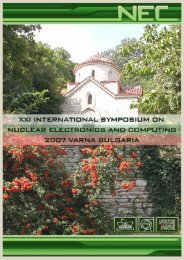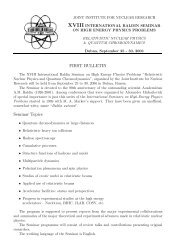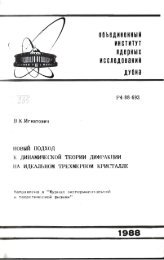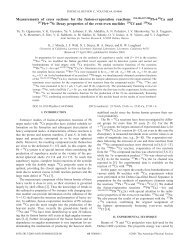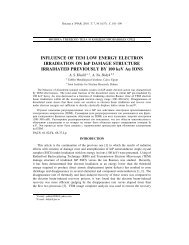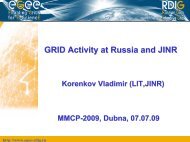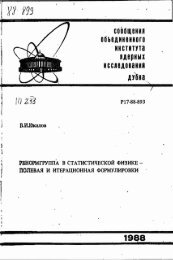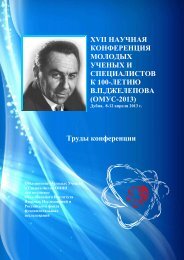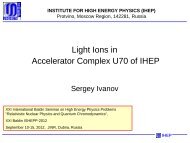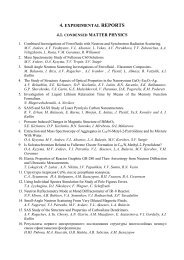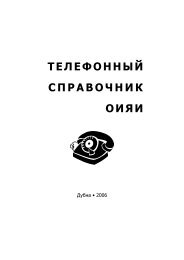Joint Institute for Nuclear Research Relativistic ... - Index of - JINR
Joint Institute for Nuclear Research Relativistic ... - Index of - JINR
Joint Institute for Nuclear Research Relativistic ... - Index of - JINR
Create successful ePaper yourself
Turn your PDF publications into a flip-book with our unique Google optimized e-Paper software.
A NEW APPROACH TO THE THEORY OF ELECTROMAGNETIC<br />
INTERACTIONS WITH BOUND SYSTEMS: CALCULATIONS OF<br />
DEUTERON MAGNETIC AND QUADRUPOLE MOMENTS<br />
A.V. Shebeko 1† , I.O. Dubovyk 2<br />
(1) National Science Center ”Kharkov <strong>Institute</strong> <strong>of</strong> Physics and Technology”, Kharkov, Ukraine<br />
(2) <strong>Institute</strong> <strong>of</strong> Electrophysics and Radiation Technologies, Kharkov, Ukraine<br />
† E-mail: shebeko@kipt.kharkov.ua<br />
We would like to show one more application <strong>of</strong> the clothed particle representation<br />
(CPR) (in particular, aimed at investigation <strong>of</strong> the e-d scattering [1, 2]. It is the case,<br />
where one has to deal with the matrix elements 〈 P ⃗′ ,M ′ |J µ (0)| P ⃗ = 0,M〉 (to be definite in<br />
the lab. frame). Here the operator J µ (0) is the Nöther current density J µ (x) at the point<br />
x = 0, sandwiched between the eigenstates <strong>of</strong> a ”strong” field Hamiltonian H, viz., the<br />
deuteron states | P ⃗ = 0,M〉 (| P ⃗′ = ⃗q,M ′ 〉) in the rest (the frame moving with the velocity<br />
⃗v = ⃗q/m d , where ⃗q the momentum transfer). These<br />
√<br />
states meet the eigenstate equation<br />
P µ | P,M〉 ⃗ = P µ d |⃗ P,M〉, with P µ d = (E d, P), ⃗ E d = ⃗P 2 +m 2 d , m d = m p + m n − ε d , the<br />
deuteron binding energy ε d > 0 and eigenvalues M = (±1,0) <strong>of</strong> the third component <strong>of</strong><br />
the total (field) angular-momentum operator in the deuteron center-<strong>of</strong>-mass (details in<br />
[3]).<br />
In the subspace <strong>of</strong> the two-clothed-nucleon states with the Hamiltonian P 0 = K F +K I<br />
and the boost operator B = B F + B I , where free parts K F and B F are ∼ b † c b c and<br />
interactions K I and B I are ∼ b † cb † cb c b c , the deuteron eigenstate acquires the <strong>for</strong>m<br />
∫ ∫<br />
|P,M〉 = dp 1 dp 2 C M ([P];p 1 µ 1 ;p 2 µ 2 )b † c(p 1 µ 1 )b † c(p 2 µ 2 )|Ω〉.<br />
When finding the C-coefficients we use the relation |⃗q,M〉 = exp[i ⃗ β ⃗ B(α c )]|0,M〉, with<br />
⃗β = β⃗n, ⃗n = ⃗n/n and tanhβ = v, that takes place owing to the property<br />
exp(i ⃗ βB)P µ exp(−i ⃗ βB) = P ν L µ ν( ⃗ β), where L( ⃗ β) is the matrix <strong>of</strong> the corresponding<br />
Lorentz trans<strong>for</strong>mation. Moreover, unlike the Bethe-Salpeter (BS) <strong>for</strong>malism, where the<br />
matrix elements <strong>of</strong> interest can be evaluated in terms <strong>of</strong> the Mandelstam current sandwiched<br />
between the deuteron BS amplitudes, our departure point is the expansion in the<br />
R-commutators<br />
J µ (0) = WJ µ c (0)W † = J µ c(0)+[R,J µ c (0)]+ 1 2 [R,[R,Jµ c (0)]]+...,(∗)<br />
in which J c µ (0) is the initial current, where the bare operators {α} are replaced by the<br />
clothed ones {α c } and W = expR the correspoding UCT. In its turn, the operator being<br />
between the two-clothed-nucleon states contributes as J µ (0) = J µ one−body +Jµ two−body , where<br />
the operator ∫<br />
J µ one−body = dp ′ dpF p,n µ (p′ ,p)b † c (p)b c(p)<br />
withF µ p,n(p ′ ,p) = eū(p ′ )F p,n<br />
1 [(p ′ −p) 2 ]γ µ +iσ µν (p ′ −p) ν F p,n<br />
2 [(p ′ −p) 2 ]u(p)thatdescribes<br />
the virtual photon interaction with the clothed proton (neutron). Its appearance follows<br />
114



